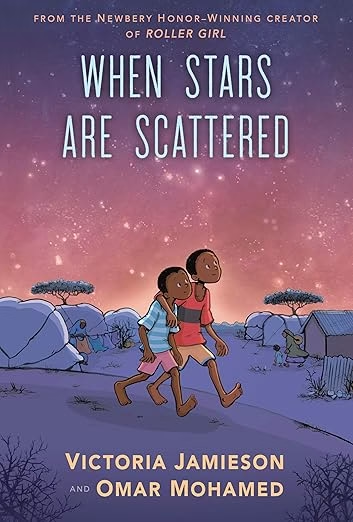When Stars Are Scattered
Victoria Jamieson and Omar Mohamed
Dial Books
Published April 14, 2020
Amazon | Bookshop | Goodreads
About When Stars Are Scattered
A National Book Award Finalist, this remarkable graphic novel is about growing up in a refugee camp, as told by a former Somali refugee to the Newbery Honor-winning creator of Roller Girl.
Omar and his younger brother, Hassan, have spent most of their lives in Dadaab, a refugee camp in Kenya. Life is hard there: never enough food, achingly dull, and without access to the medical care Omar knows his nonverbal brother needs. So when Omar has the opportunity to go to school, he knows it might be a chance to change their future . . . but it would also mean leaving his brother, the only family member he has left, every day.
Heartbreak, hope, and gentle humor exist together in this graphic novel about a childhood spent waiting, and a young man who is able to create a sense of family and home in the most difficult of settings. It’s an intimate, important, unforgettable look at the day-to-day life of a refugee, as told to New York Times Bestselling author/artist Victoria Jamieson by Omar Mohamed, the Somali man who lived the story.
My Review
After reading this graphic novel, I’m completely unsurprised that this book was a finalist for the National Book Award. What an incredible story. It’s definitely one of those books that is more than the sum of its parts, too. While the storytelling follows Omar’s experience from his childhood living in a refugee camp in Kenya to his adulthood, the relationships in the book shine like its true stars.
Omar takes care of his brother Hassan, who is mostly nonverbal and has seizures. As Omar attends school, he worries about Hassan being on his own. He realizes, though, that Hassan has a whole community of people who know and love him. And he helps everyone around him, as well.
At school, Omar makes friends with Maryam and Nimo, two girls who study hard, hoping to one day earn a scholarship that would take them to college in Canada. His best friend, Jeri, keeps Omar grounded when his emotions get the best of him.
Omar’s life experiences are so different than a lot of kids face. An up-close account showing what it’s like to live day after day with so little and no promise that life will ever change helps readers develop empathy and understanding for refugees who might join their classrooms.
The backmatter shows some photos of Omar and Hassan as well as a continuation of Omar’s life story.
I’m a huge fan of When Stars Are Scattered, and I hope to share it with lots of young readers.
Content Notes
Recommended for Ages 10 to 14.
Profanity/Crude Language Content
None.
Romance/Sexual Content
Reference to marriage. One of Omar’s friends, a girl who is around fifteen years old, marries an older man.
Spiritual Content
References to morning prayer, studing the Quran, and celebrating holidays like Ramadan and Eid.
Violent Content
Omar revisits his life in Somalia in fragmented memories (he fled when he was around three years old). One panel shows that Omar heard shots fired after soldiers approached his dad. The text doesn’t specify what he saw, but we understand that he witnessed his dad’s death, and that remembering it was deeply upsetting to him. One line references a suicide (not shown on scene). References to domestic abuse.
People in the camp call Omar’s friend Jeri “Limpy” to make fun of him for his disability. Omar and Jeri talk specifically about this and how it’s wrong and bothers Jeri. Omar sticks up for his friend.
Drug Content
One character’s dad sits with other men chewing Khat leaves, which act like a stimulant.
Note: This post contains affiliate links, which do not cost you anything to use but help support this blog. I purchased a copy of this book from Scholastic Book Fairs. All opinions are my own.
